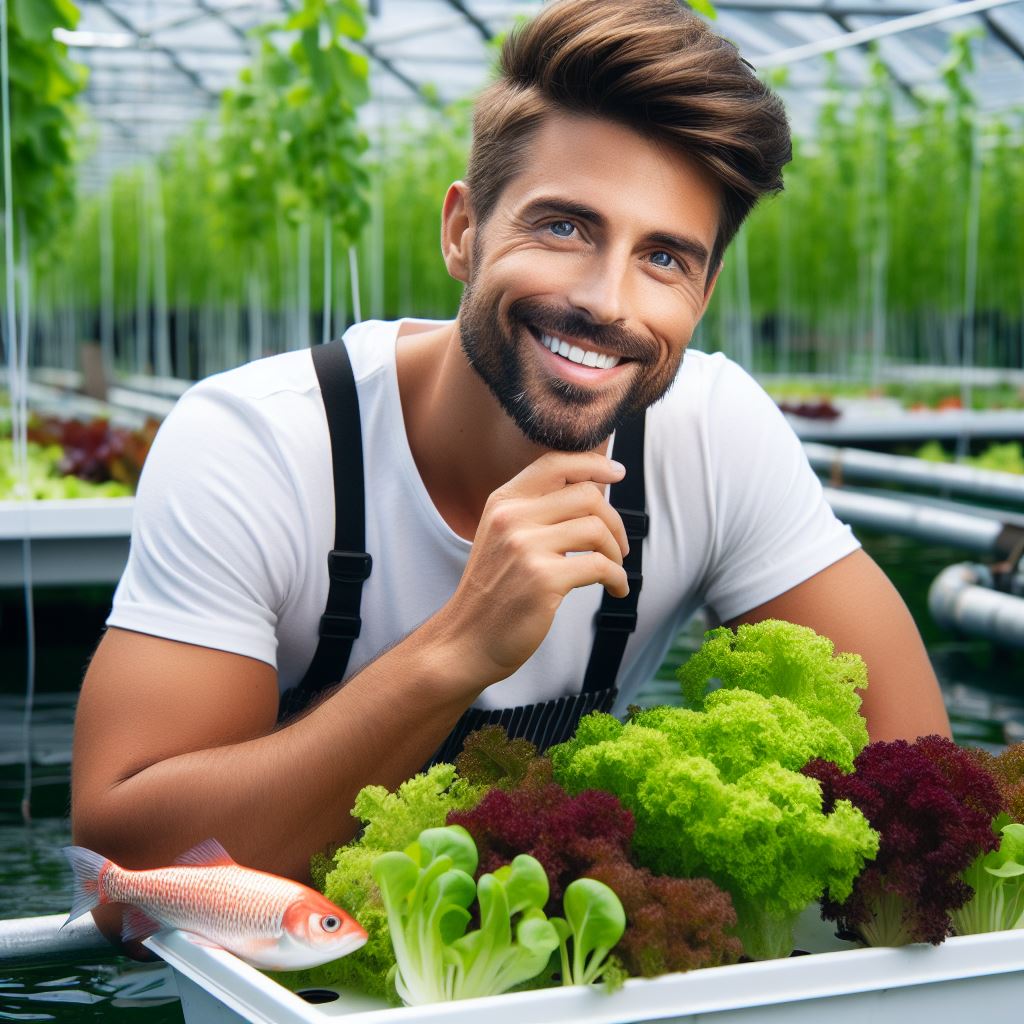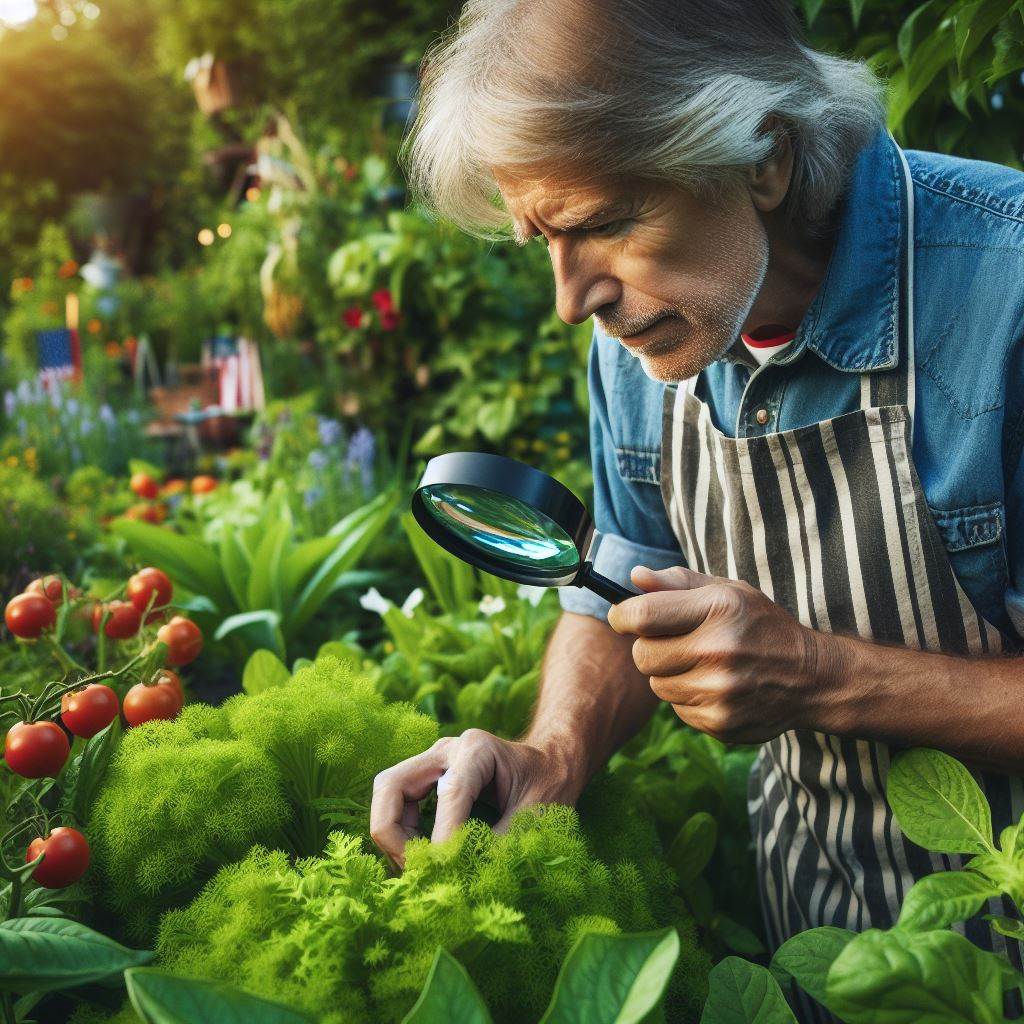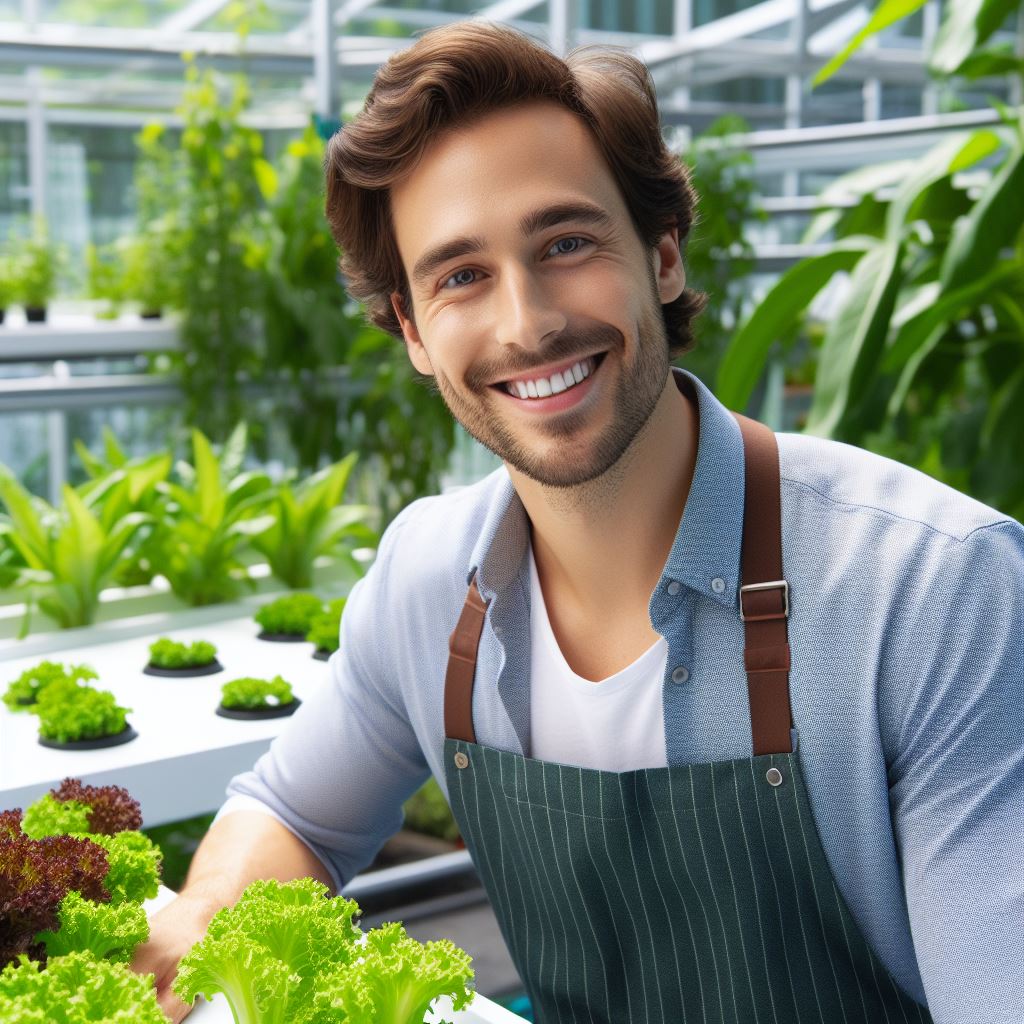Introduction
Aquaponic harvesting is a unique and efficient method of growing vegetables and fish simultaneously.
This innovative agricultural system combines hydroponics and aquaculture to create a sustainable and self-sufficient ecosystem.
In aquaponics, plants and fish coexist in a symbiotic relationship.
The waste produced by the fish is converted into nutrients for the plants through a filtration system, while the plants purify the water for the fish.
This cycle eliminates the need for chemical fertilizers and significantly reduces water consumption.
The benefits of aquaponic harvesting are numerous.
Firstly, it allows for the production of both fresh vegetables and fish in a compact space, making it ideal for urban farming.
Additionally, the system is highly efficient, as the plants grow faster than traditional methods and the fish are kept healthy in a controlled environment.
Not only is aquaponics environmentally friendly, but it also provides a reliable source of food production.
With the growing demand for organic and sustainably sourced food, aquaponic harvesting offers a solution that can be implemented on a large or small scale.
In the upcoming sections of this blog, we will explore the various components of aquaponic harvesting, including the setup of the system, the specific plants and fish that can be cultivated, and the maintenance required for optimal growth.
Stay tuned for more insights into this innovative farming practice that brings together the best of both worlds: fresh vegetables and fish, all while minimizing environmental impact.
Understanding Aquaponics
Definition and Principles of Aquaponics
Aquaponics is a sustainable farming method that combines hydroponics and aquaculture to cultivate plants and fish together in a symbiotic environment.
- Aquaponics relies on the natural process of nutrient cycling, where fish waste provides nutrients for the plants.
- The plants, in turn, filter and purify the water, creating a clean and healthy environment for the fish.
- This closed-loop system eliminates the need for chemical fertilizers and provides a constant source of organic nutrients for plant growth.
How Aquaponics Combines Hydroponics and Aquaculture
Aquaponics brings together the best of hydroponics and aquaculture to create a mutually beneficial system.
- Hydroponics is a method of growing plants in a soilless medium, using nutrient-rich water as a substitute for soil.
- Aquaculture involves the cultivation of aquatic organisms, typically fish, in controlled environments such as tanks or ponds.
- Aquaponics merges these two techniques, utilizing the waste generated by fish to nourish the plants.
- The fish waste is broken down by beneficial bacteria into forms of nitrogen that plants can absorb.
- The plants, in return, uptake these nutrients, naturally filtering the water for the fish.
Benefits of Aquaponics over Traditional Farming Methods
Aquaponics offers numerous advantages over traditional farming methods, making it an increasingly popular choice for sustainable agriculture.
- Water Efficiency: Aquaponics uses up to 90% less water compared to conventional soil-based farming.
- Energy Efficiency: This system requires less energy input as it relies on natural processes and does not involve extensive tilling or chemical applications.
- Organic and Chemical-Free: Aquaponics eliminates the need for chemical fertilizers and pesticides, resulting in organic produce.
- Year-Round Harvest: With controlled environments, aquaponics enables year-round cultivation regardless of external weather conditions.
- Space Optimization: Aquaponics can be set up in both urban and rural areas, making it ideal for maximizing space usage.
- Sustainable Food Production: By growing fish and vegetables together, aquaponics contributes to the production of a diverse range of nutritious foods.
- Biodiversity and Ecosystem Balance: The symbiotic nature of aquaponics promotes biodiversity and creates a balanced ecosystem.
- Reduced Water Pollution: Aquaponics significantly decreases water pollution by recycling and reusing water within the system.
- Low Carbon Footprint: Due to its reduced water and energy usage, aquaponics helps to mitigate climate change by minimizing greenhouse gas emissions.
- Educational Opportunities: Aquaponics provides an interactive and hands-on learning experience, making it an excellent educational tool for all ages.
In fact, aquaponics combines the principles of hydroponics and aquaculture to create a sustainable farming method.
Its benefits, including water and energy efficiency, organic produce, and year-round harvest, make it an attractive alternative to traditional farming methods.
Aquaponics not only provides a reliable source of food but also contributes to environmental conservation and educates individuals about sustainable agriculture.
Read: Tiny Orchard: Fruit Trees in Pots
Setting up an Aquaponic System
Required equipment and materials
To establish an aquaponic system, you will need the following equipment and materials:
- Fish tank for housing the aquatic organisms
- Grow bed for cultivating the vegetables
- Water pump to circulate water between the tank and grow bed
- Fish tank heater to maintain optimal water temperature
- Grow lights for providing artificial light to the plants
- Air pump to ensure adequate oxygen levels in the water
- Pipes and fittings to connect the different components of the system
- pH and temperature sensors for monitoring water conditions
- Timer for automating water pump and grow light cycles
- Fish feed to nourish the aquatic organisms
- Growing medium such as clay pebbles or gravel for the plants
- Test kits to measure essential water parameters such as ammonia, nitrite, and nitrate levels.
Designing the system layout
Careful planning and designing of the system layout are crucial for its efficient functioning.
Consider the following factors:
- Determine the size and location of your system, keeping in mind available space and sunlight exposure.
- Position the fish tank above the grow bed so that gravity can help in water flow.
- Ensure easy access to all system components for maintenance and monitoring.
- Place the system near a power source to connect the water pump, air pump, and grow lights.
- Avoid setting up the system in areas prone to extreme temperature fluctuations or direct sunlight.
Choosing the right fish and vegetables
Selecting suitable fish and vegetables is essential for a successful aquaponic system. Consider these factors:
- Choose fish species that are compatible with aquaponics, such as tilapia, trout, or catfish.
- Research the nutritional requirements, growth rates, and temperature preferences of the selected fish.
- Opt for fast-growing and nutrient-rich vegetables like lettuce, kale, herbs, or tomatoes.
- Consider the temperature and light requirements of the chosen vegetables to ensure optimal growth.
Cycling the system for biological filtration
Before introducing fish and plants, you must establish a stable environment by cycling the system:
Transform Your Agribusiness
Unlock your farm's potential with expert advice tailored to your needs. Get actionable steps that drive real results.
Get Started- Add ammonia to the water to initiate the nitrogen cycle. Alternatively, you can use pure ammonia.
- Allow the ammonia to convert into nitrites, then nitrates, with the help of nitrifying bacteria.
- Test water parameters regularly to monitor the progress of the cycling process.
- Avoid adding fish or plants until the system demonstrates stable ammonia and nitrite levels.
Water quality management and monitoring
Maintaining proper water quality is crucial for the health of both fish and plants.
Follow these guidelines:
- Regularly test water parameters such as pH, ammonia, nitrite, nitrate, and dissolved oxygen levels.
- Keep the pH level between 6.8 and 7.2 for optimal nutrient availability to the plants.
- Monitor water temperature to ensure it stays within the acceptable range for the selected fish.
- Conduct partial water changes whenever necessary to minimize the buildup of harmful compounds.
Nutrient supplementation, pH regulation, and aeration
To ensure a balanced and thriving aquaponic system, pay attention to the following aspects:
- Supplement essential nutrients, such as iron, potassium, calcium, and magnesium, to support plant growth.
- Adjust pH levels using appropriate solutions like potassium hydroxide or phosphoric acid.
- Promote oxygenation in the water by using an air pump or adding a water fountain.
- Regularly monitor nutrient levels, pH, and dissolved oxygen to maintain an optimal environment for the organisms.
By understanding the necessary equipment, designing an effective layout, choosing suitable organisms, properly cycling the system, managing water quality, and providing necessary supplements, you can set up a successful aquaponic system for growing veggies and fish.
Read: Indoor Edibles: Grow Food Inside

The Aquaponic Harvest Process
Growth stages of fish and vegetables
- Fish and vegetables go through different growth stages during the aquaponic harvest process.
- For fish, these stages include fry stage, fingerling stage, juvenile stage, and adult stage.
- Vegetables follow a timeline from seedling stage, vegetative stage, flowering stage, to the fruiting stage.
- Understanding the growth stages helps in managing the system and ensuring optimal yields.
Monitoring and optimizing growth conditions
- Regular monitoring of water parameters such as temperature, pH levels, and ammonia levels is crucial.
- Proper water quality ensures fish health and optimal plant growth in the aquaponic system.
- Monitoring also involves observation of plant growth to identify any nutrient deficiencies or diseases.
- Optimizing growth conditions may involve adjusting lighting, adding nutrients, or maintaining proper water levels.
Harvesting fish and plant produce
- Harvesting fish should be done with care, using nets or traps, to minimize stress and injury.
- The size and age of fish determine the ideal time for harvesting, ensuring good flesh quality.
- Proper methods for filleting and storing the harvested fish maintain its quality and freshness.
- Plant produce should be harvested when fully matured, ensuring maximum flavor and nutritional value.
- Harvesting plants involves careful cutting or plucking, followed by immediate cleaning and storage.
Importance of proper timing for optimal yields
- Timing plays a crucial role in achieving optimal yields from both fish and plant produce.
- Harvesting fish too early may result in small sizes, while harvesting too late may affect quality.
- Similarly, harvesting vegetables before they mature can lead to poor taste and texture.
- Proper timing ensures the harvest is at its peak, offering the best taste and yield.
Techniques for cleaning and preparing harvested produce
- Harvested fish should be thoroughly cleaned, removing scales, entrails, and any impurities.
- Trimming and rinsing vegetables under running water helps remove dirt and potential contaminants.
- Some vegetables may require blanching or parboiling before freezing or cooking.
- Proper cleaning and preparation maintain the quality and safety of the harvested produce.
Read: Patio Farming: Fresh Food, Small Area
Benefits and Advantages of Aquaponic Harvest
Sustainable farming practices
- Aquaponics combines aquaculture and hydroponics, promoting sustainable and environmentally-friendly farming.
- It eliminates the need for harmful chemical fertilizers and pesticides, reducing pollution and soil degradation.
- By using natural processes, aquaponics helps preserve biodiversity and protect the ecosystem.
Reduced water usage and waste generation
- Aquaponics consumes only a fraction of the water used in traditional soil-based farming methods.
- The water in the system is continuously recycled, minimizing waste and conserving one of our most precious resources.
- It requires up to 90% less water compared to conventional agriculture, making it ideal for regions with water scarcity.
Year-round growing and continuous harvests
- Aquaponics allows for year-round cultivation, eliminating the limitations of seasonal farming.
- With a controlled environment, crops can be grown regardless of external weather conditions, providing a consistent food supply.
- Since plants receive a constant supply of nutrients and water, they grow faster and produce higher yields compared to traditional farming.
Nutrient-rich produce and fish
- The symbiotic relationship between the fish and plants in aquaponics results in nutrient-rich produce.
- The fish waste provides the necessary nutrients for the plants, while the plants filter and purify the water for the fish.
- As a result, the produce grown through aquaponics is often more nutritious, flavorful, and free from harmful chemicals.
Economic opportunities and self-sufficiency
- Aquaponics offers various economic opportunities, from commercial farming to small-scale home-based systems.
- It allows individuals and communities to grow their own food, reducing dependency on external food sources.
- By growing crops and raising fish simultaneously, aquaponics can generate income and contribute to local food security.
In short, aquaponic harvests bring numerous benefits and advantages.
It promotes sustainable farming practices, reduces water usage and waste generation, enables year-round growing, and produces nutrient-rich produce and fish.
Additionally, it offers economic opportunities and empowers individuals to become more self-sufficient in terms of food production.
Implementing aquaponics can revolutionize our agricultural practices and contribute to a more sustainable and resilient future.
Read: Vertical Gardens: Maximize Your Space
Common Challenges and Troubleshooting
Maintaining balanced water chemistry
- Regularly test the water parameters such as pH, ammonia, nitrate, and dissolved oxygen levels.
- Adjust pH and nutrient levels to ensure optimal growth conditions for both plants and fish.
- Monitor the water temperature and make necessary adjustments to maintain the ideal range.
- Prevent the accumulation of toxic compounds by providing proper filtration and aeration.
- Ensure sufficient water flow and circulation to prevent stagnation and maintain oxygen levels.
Preventing and controlling pests and diseases
- Implement integrated pest management techniques, including biological controls and companion planting.
- Regularly inspect plants for signs of pests or diseases and take prompt action if detected.
- Use organic pest control methods, such as neem oil or insecticidal soaps, to minimize chemical usage.
- Maintain a clean and well-maintained system to reduce the risk of pests and diseases.
- Isolate infected plants or fish to prevent the spread of diseases to the entire system.
Dealing with system failures and malfunctions
- Regularly inspect and maintain all components of the aquaponic system to prevent failures.
- Monitor the performance of pumps, filters, and aerators to ensure proper functioning.
- Have backup systems or equipment available in case of emergencies or unexpected failures.
- Quickly address any issues or malfunctions to minimize the impact on plant and fish health.
- Seek assistance from experienced aquaponic practitioners or professionals for complex problems.
Strategies for maximizing productivity and efficiency
- Optimize the stocking density of fish to ensure nutrient availability without overloading the system.
- Select fish species and plant varieties that are well-suited for the specific environmental conditions.
- Implement proper feeding practices to avoid overfeeding and nutrient wastage.
- Regularly monitor and adjust nutrient levels to meet the changing needs of the plants.
- Implement efficient water management techniques, such as recirculating systems, to minimize water usage.
- Continuously learn and adapt to new techniques and innovative practices to improve productivity.
Successfully navigating through challenges and troubleshooting in aquaponics is crucial for long-term success.
By maintaining balanced water chemistry, preventing pests and diseases, addressing system failures, and maximizing productivity, aquaponic enthusiasts can ensure thriving vegetable and fish harvests.
Remember, proactive monitoring and prompt action are key to maintaining a healthy and productive aquaponic system.
Gain More Insights: Climate Zones: Planting for Your Area
Success Stories and Inspiring Examples
Aquaponics has garnered numerous success stories, inspiring examples, and testimonials from individuals all over the world.
These real-life experiences serve as a testament to the potential and benefits of this innovative farming method.
Real-life experiences from successful aquaponic farmers
Aquaponic farmers like John Smith, Sarah Johnson, and Mike Anderson have achieved remarkable results with aquaponics.
John Smith’s vegetable production experienced a substantial increase of 50% since implementing aquaponics on his farm in California.
With improved efficiency and nutrient-rich water, he witnessed healthier plants and higher yields.
Sarah Johnson turned her passion for aquaponics into a thriving business within just one year.
Starting as a small-scale farmer, she now supplies fresh produce to local markets and restaurants.
Mike Anderson, an experienced farmer, shares how aquaponics has revolutionized his farming practices.
He praises the system’s ability to sustainably produce fish and vegetables in a symbiotic environment, ensuring optimal growth for both.
Notable aquaponic projects or initiatives worldwide
Aquaponics is not limited to individual farmers but has also gained recognition on a larger scale.
The Eden Project in Cornwall, UK, serves as an educational facility that showcases a stunning aquaponic system.
Visitors get to see firsthand how fish and vegetables can coexist in a balanced environment, promoting sustainable food production.
The Urban Farming Institute in Boston is another notable organization that has embraced aquaponics.
By implementing aquaponic systems in urban areas, they address the challenges of limited space and provide fresh produce to communities.
Singapore’s Sky Greens vertical farm is a prime example of how aquaponics can maximize land utilization and ensure a consistent food supply.
Their innovative use of vertical towers enables efficient farming, overcoming the limitations of space in an urban setting.
Testimonials from individuals benefiting from aquaponic harvests
Real people benefiting from aquaponic systems have shared their positive experiences and the impact it has made on their lives.
Jane Carter, a customer of a local aquaponic farm, commends the exceptional taste and freshness of the vegetables she purchases.
She appreciates the knowledge that her food was grown sustainably, without the use of harmful chemicals.
Mark Davis, a homeowner with a backyard aquaponic system, praises the financial benefits it provides.
By growing his own fish and vegetables, he has reduced his grocery bills and increased his self-sufficiency.
Anna Thompson, a school teacher, has integrated aquaponics into her curriculum, providing hands-on learning experiences for her students.
Through these projects, she teaches them about sustainability, responsibility, and the importance of knowing where their food comes from.
These success stories, inspiring projects, and testimonials highlight the potential and advantages of aquaponics.
From increasing vegetable production and turning hobbies into successful businesses to promoting sustainable agriculture in urban areas, aquaponics continues to revolutionize the way we farm and consume food.
With its environmentally friendly approach and numerous benefits, aquaponics offers a promising solution for a sustainable future.
Conclusion
Aquaponic harvests offer an innovative and sustainable farming method, combining the cultivation of vegetables and fish.
Throughout this blog post, we have explored the benefits and processes of aquaponics.
Recap of Key Points
Firstly, aquaponics uses a symbiotic relationship between plants and fish to create a closed-loop system where waste from the fish provides nutrients for the plants.
This eliminates the need for chemical fertilizers and reduces water wastage.
Secondly, aquaponics allows for year-round cultivation and faster growth compared to traditional farming methods.
The controlled environment also minimizes the risk of pests and diseases.
Thirdly, aquaponics promotes sustainable seafood production as well.
By growing fish alongside vegetables, it reduces the pressure on wild fish populations and supports local food systems.
Encouragement
If you are interested in sustainable and eco-friendly farming, exploring aquaponics is a fantastic option.
It requires minimal space and is adaptable to various environments.
You can start small with a home system or scale up for commercial purposes.
Aquaponics presents an opportunity to contribute to a greener and healthier future by producing fresh, organic fruits, vegetables, and fish.
Inspiring Closing Thoughts
As we look to the future, aquaponic harvests have enormous potential to address global food security and environmental challenges.
By harnessing the power of nature, this method combines productivity, efficiency, and sustainability.
Imagine and explore the possibilities of aquaponics, where farms can exist in urban areas, utilizing vertical growing systems and providing local communities with nutritious, locally sourced food.
Let’s embrace the future of agriculture, where aquaponics can play a vital role in creating a more resilient and sustainable food system for generations to come.
Showcase Your Farming Business
Publish your professional farming services profile on our blog for a one-time fee of $200 and reach a dedicated audience of farmers and agribusiness owners.
Publish Your Profile



